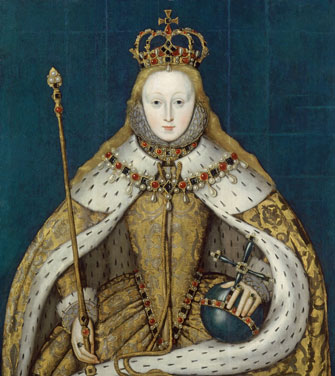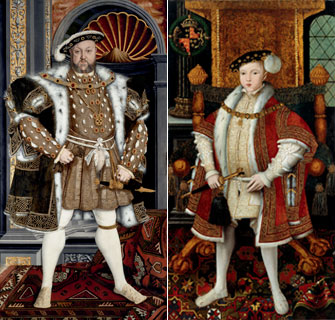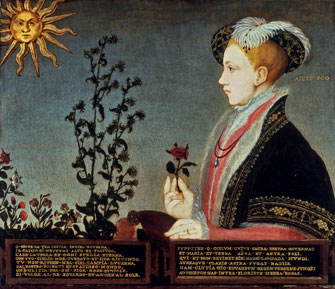The True Story Behind
A Royal Soap Opera

“Elizabeth I” (detail, c. 1600), by an English artist. © National Portrait Gallery, London, England
The Musée du Luxembourg is holding another one of its enjoyably didactic biographical-historical exhibitions, similar to last year’s show on Empress Joséphine, but this time about a neighboring dynasty from Perfide Albion across the Channel, the Tudors.
The dramatic possibilities of the Tudors – subject of uncountable works of art – cannot be denied, given that the leading role goes to the formidable Henry VIII, husband of six women, two of whom he had separated from their heads, and father of the nearly equally formidable Elizabeth I. More importantly for world history, he was responsible for separating the British Isles from the Catholic Church.
The exhibition is a visual demonstration of how the Tudors, who reigned from 1485 to 1603, burnished their image for the benefit of the public. It begins just after the War of the Roses, which ended with the death in battle of Richard III and brought the House of Tudor to power. The white and red roses of, respectively, the warring Houses of York and Lancaster were united symbolically in the coat of arms of the Tudors. The two houses were also united by the marriage of the first Tudor king, Henry VII (a distant descendant of the Lancasters), to Elizabeth of York.
As usurpers of the throne, the Tudors needed to establish their legitimacy. As the exhibition points out, the combination of the two roses, the York white subsumed by the Lancaster red and topped by a crown, said it all. This symbol is found here in a variety of objects and paintings, including books belonging to and portraits of the family of Henry VII.
His most famous child was, of course, the oft-represented Henry VIII. One of the fascinating exhibits here is the king’s personal armor. If you have ever remarked how small centuries-old armor often is, you will be struck by the relatively large size of Henry’s skirted metal suit, made for a tournament in 1520 and apparently impenetrable. His stature was emphasized and even exaggerated by sumptuous portraits, in which he fairly blusters, his legs spread wide and arms akimbo to make him appear larger and to firmly establish his virility and power, notably in the famous portrait by Han Holbein the Younger (1540-50), a copy of which is presented here.
Henry had a problem, however: no sons, which is what led to his taking (and dispensing) of serial wives. The six wives have a section of their own in the show, although an authenticated contemporary image exists for only of them, Anne of Cleves. The portraits of the other wives shown here are the imaginings of later artists.
One of the most interesting artifacts in this section is a small gold and enamel whistle pendant with tiny implements unfolding from it like a Swiss Army knife. One wonders why Henry gave this cunning piece to Anne Boleyn. So she could pucker up her lips and whistle when she felt like making a son?
Henry finally did have a son, Edward, by his third wife, Jane Seymour, who died in childbirth in 1537. Edward VI succeeded his father as king at the age of nine but died at 15. During his short reign he, too, was aggrandized in art as his father had been before him. He

Left: “Henri VIII” (1540-50), after Hans Holbein the Younger. © West Sussex, Petworth House, National Trust. On his right, his son “Edward VI” (c. 1547), atelier of “Master John.” © National Portrait Gallery, London, England
was even painted in the same wide-legged, arms-akimbo stance in a portrait by the atelier of “Master John” on show here.
Another symbol-laden painting of the boy-king, attributed to Guillim Scrotts, shows him in profile with a text below describing him

“Edward VI”(c. 1547), attributed to Guillim Scrots (also known as Stretes). © Compton Verney, Warwickshire
as the second Jupiter. Accordingly, the heliotropes in the painting turn toward him rather than the sun shining in the upper left-hand corner.
The premature death of Edward VI paved the way for the first queens of England, first Mary, daughter of Catherine of Aragon (marriage annulled for lack of a son, causing the split with the Catholic Church), who reigned for five years, followed by her half-sister Elizabeth, daughter of Anne Boleyn (decapitated), the Virgin Queen, who sat on the throne from 1558 to 1603 and is best known for never marrying, for having her Catholic cousin Mary, Queen of Scots executed, and for reigning over the flowering of English literature, notably through her patronage of her talented subject William Shakespeare. The splendiferous portaits of her in the exhibition show that she carried on her father’s tradition by having herself portrayed in her full magnificence.
To my mind, however, the two most beautiful things in the exhibition are the simplest: elegant line drawings by Holbein the Younger of Edward VI as a child (c. 1540-42) and of his half-sister Mary (c. 1542).
The reign of the Tudors came to an end with the death of the childless Elizabeth. No one can say that the Tudor era was uneventful. To this day, the dynasty continues to provide fodder for storytellers in every genre, whether works of history, biographies, novels, films or soap operas. This exhibition does a fine job of telling the story simply and clearly. For more detail and drama (historical accuracy not guaranteed), there are always the reruns of the TV series “The Tudors.”
Musée du Luxembourg: 19, rue de Vaugirard, 75006 Paris. Métro: Saint-Sulpice or Odéon. RER: Luxembourg. Tel.: 01 40 13 62 00. Open daily, 10am-7pm, until 10pm on Mondays. Closed May 1. Admission: €12. Through July 19, 2015.
Reader reaction: Click here to respond to this article (your response may be published on this page and is subject to editing).
Please support Paris Update by ordering books from Paris Update’s Amazon store at no extra cost. Click on your preferred Amazon location: U.K., France, U.S.
More reviews of Paris art shows.
© 2015 Paris Update
Favorite